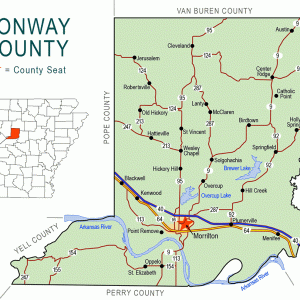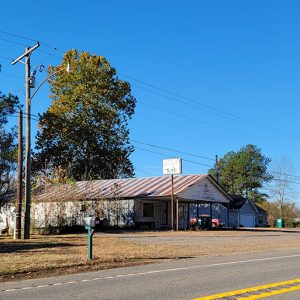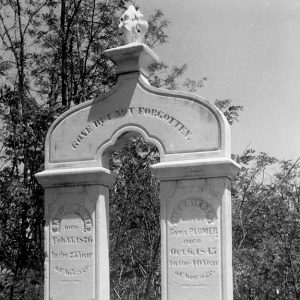calsfoundation@cals.org
Plumerville (Conway County)
| Latitude and Longitude: | 35º09’36″N 092º38’27″W |
| Elevation: | 299 feet |
| Area: | 1.03 square miles (2020 Census) |
| Population: | 734 (2020 Census) |
| Incorporation Date: | November 25, 1880 |
Historical Population as per the U.S. Census:
|
1810 |
1820 |
1830 |
1840 |
1850 |
1860 |
1870 |
1880 |
1890 |
1900 |
|
– |
– |
– |
– |
– |
– |
– |
135 |
214 |
296 |
|
1910 |
1920 |
1930 |
1940 |
1950 |
1960 |
1970 |
1980 |
1990 |
2000 |
|
495 |
702 |
613 |
541 |
550 |
586 |
724 |
785 |
832 |
854 |
|
2010 |
2020 |
|
|
|
|
|
|
|
|
|
826 |
734 |
|
|
|
|
|
|
|
|
Plumerville was formed as a stagecoach stop in 1858, but the origins of the community are found along the Arkansas River in the early days of the Arkansas Territory. The community moved from the Harrisburg-Portland bottomland area to follow stagecoach and railroad developments.
Samuel Plummer came to the area in 1833 and purchased 160 acres of the “first high ground” north of the Arkansas River. Over the next several years, the development of the Military Road from Little Rock (Pulaski County) to Fort Smith (Sebastian County) led to a stop on the Butterfield Overland Mail Company and the construction of the telegraph line across this important choice of land. The later railroad also needed to avoid the overflow areas and negotiated with Plummer for right-of-way. As a result of his cooperation, in 1873 Plummer’s Station was recognized as a full stop on the new rail line.
The community soon became the leading business, agricultural, and political center in the region. The city of Plumerville was incorporated in 1880 and continued its expansion until the Great Depression. During the development, the community became the focus of the state and the nation when John Middleton Clayton, former governor Powell Clayton’s brother, was killed at a rooming house owned by Mary Ann McCraven in 1889 as he challenged the election returns in his race for Congress. Political unrest and violence so marked the community that Plumerville was specifically mentioned by Frederick Douglass in his visit to Arkansas later that year. In 1912, an African American man named John Williams was lynched near Plumerville.
The city continued to prosper during early twentieth century and became a major agricultural commerce center. The farming economy was so good that the Bank of Plumerville was the target of three successful robberies. During those years, Plumerville was very progressive and created significant city services, including a fire department, telephone exchange, and the lighting of the city streets with natural gas around 1906. The gas was discovered as the city expanded its water system. One of the street lamps still remains on Springfield Street, near Arkansas Highway 64.
The Great Depression, the Floods of 1927 and 1937, and a relocation of U.S. Highway 64 north of the city initiated a significant decline for the community. A number of people left Plumerville, including the family of John Yancey, which relocated to Little Rock; Yancey was born in Plumerville in 1918 and later became a highly decorated Marine. Devastating fires, the cessation of passenger train service, and greater mobility within the region also combined to make the community no longer competitive.
Plumerville residents developed a public school program and actively supported consolidation of rural schools in the area. By 1931, Plumerville had one of only four high schools in Conway County. The Plumerville School Building is a circa 1925 wood-frame structure that was remodeled to serve as a school in 1939. The schools were well supported and successful in both academics and athletic programs until merging into the South Conway School District in 1979. The Arch Ford Education Service Cooperative is based at the former high school. This educational cooperative serves twenty-six school districts in seven counties, employing 150 people who provide leadership development and technical assistance for effective teaching.
Plumerville has a mayor-council form of government that provides conventional city services that include police and district court services, as well as participation in the Conway County water system. Fire and emergency services are provided by a well-established volunteer program. The community has evolved into a quiet residential setting that continues to support the large row-crop farming operations in the nearby bottomlands.
For additional information:
Barnes, Kenneth C. Who Killed John Clayton? Political Violence and the Emergence of the New South, 1861–1893. Durham, NC: Duke University Press, 1998.
Conway County, Arkansas: Our Home, Our Land, Our People. Little Rock: Historical Publications of Arkansas, 1992.
Mozingo, William Elmer. “History of Plumerville, Arkansas.” Master’s thesis, Arkansas State Teachers College, 1960.
Larry Taylor
Springfield, Arkansas



























Comments
No comments on this entry yet.